Experimental and Numerical Study of Water–Rock Coupling Creep under Uniaxial Compression
Abstract
:1. Introduction
2. Experimental Sample and Scheme
2.1. Sample Preparation and Basic Properties
2.2. Design of Creep Experiment
3. Experimental Results and Analysis
3.1. Analysis of Strength-Softening Experiment Results
3.2. Creep Experiment Results
4. Constitutive Creep Damage Model
4.1. Damage Variable
4.2. Accelerated Creep Model
5. Numerical Calculation
5.1. Damage Calculation Model
5.2. Numerical Model and Calculation Parameters
6. Conclusions
- (1)
- In this paper, uniaxial compression experiments and the uniaxial compression creep experiments using five kinds of sandstone samples with different moisture contents were carried out. The experimental results showed that the compressive strength, the elastic modulus, and the parameters related to the long-term strength had negative exponential relationships with the moisture content. The isochronous viscoelastic curve was obtained using the curve of uniaxial compression step loading of the whole creep process. The critical stress of different stages of creep also had a negative exponential relationship with the water content, but there was a stable proportional relationship between it and the uniaxial compressive strength.
- (2)
- A new viscous modulus () was introduced to describe the evolution law of the viscous strain in the whole creep process according to the slope change of the isochronous viscoelastic curve, and the nonlinear softening equation with the change in the moisture content was obtained. At the same time, a new viscous modulus was defined based on the accelerated creep deformation law of uniaxial graded loading creep. A nonlinear viscous kettle model with strain triggering was introduced to describe the accelerated creep process. In addition, a new creep constitutive model was derived, and the creep equation was given.
- (3)
- According to the viscoelastic constitutive relation, the iterative incremental form of the improved Nishihara model based on the D-P criterion was established. The calculation curves of the creep process of sandstone were obtained using ABAQUS software and were in good agreement with the experimental creep curves. The whole creep process of sandstone can be accurately simulated, and it provided a new research idea to study the creep process of sandstone using the method of numerical simulation.
Author Contributions
Funding
Institutional Review Board Statement
Informed Consent Statement
Data Availability Statement
Conflicts of Interest
References
- Price, N.J. The compressive strength of coal measure rocks. Colliery Eng. 1960, 37, 283–292. [Google Scholar]
- Hadizadeh, J.; Law, R.D. Water-weakening of sandstone and quartzite deformed at various stress and strain rates. Int. J. Rock Mech. Min. Sci. Geo-Mech. Abstr. 1991, 28, 431–439. [Google Scholar] [CrossRef]
- Shakoor, A.; Barefield, E.H. Relationship between Unconfined Compressive Strength and Degree of Saturation for Selected Sandstones. Environ. Eng. Geosci. 2009, 15, 29–40. [Google Scholar] [CrossRef]
- Erguler, Z.A.; Ulusay, R. Water-induced variations in mechanical properties of clay-bearing rocks. Int. J. Rock Mech. Min. Sci. 2009, 46, 355–370. [Google Scholar] [CrossRef]
- Li, D.J.; Wang, G.L.; Han, L.Q. Analysis of microscopic pore structures of rocks before and after water absorption. Min. Sci. Techno. 2011, 21, 287–293. [Google Scholar]
- Rajabzadeh, M.A.; Moosavinasab, Z.; Rakhshandehroo, G. Effects of rock classes and porosity on the relation between uniaxial compressive strength and some rock properties for carbonate rocks. Rock Mech. Rock Eng. 2012, 45, 113–122. [Google Scholar] [CrossRef]
- Burshtein, L.S. Effect of moisture on the strength and deformability of sandstone. Soviet Min. 1969, 5, 573–576. [Google Scholar] [CrossRef]
- Sun, X.M.; Jiang, M.; Wang, X.B.; Zang, J.C.; Gao, X.; Miao, C.Y. Experimental study on creep mechanical properties of sandstone with different water contents in Wanfu coal mine. Rock Soil Mech. 2023, 44, 624–636. [Google Scholar]
- Guo, H.Y.; Li, B.; Sun, C.H. Hydrophilic characteristics of soft rock in deep mines. Int. J. Min. Sci. Techno. 2015, 25, 177–183. [Google Scholar] [CrossRef]
- Miao, C.Y.; Yang, L.; Xu, Y.Z.; Yang, K.; Sun, X.M.; Jiang, M.; Zhao, W.C. Experimental study on strength softening behaviors and micro-mechanisms of sandstone based on nuclear magnetic resonance. Chin. J. Rock Mech. Eng. 2021, 40, 2189–2198. [Google Scholar]
- Feng, F.; Chen, S.; Han, Z.; Golsanami, N.; Liang, P.; Xie, Z. Influence of moisture content and intermediate principal stress on cracking behavior of sandstone subjected to true triaxial unloading conditions. Eng. Fract. Mech. 2023, 284, 109265. [Google Scholar] [CrossRef]
- Wong, L.; Maruvanchery, V.; Liu, G. Water effects on rock strength and stiffness degradation. Acta Geotech. 2016, 11, 713–737. [Google Scholar] [CrossRef]
- Griggs, D.T. Creep of rocks. J. Geol. 1939, 47, 225–251. [Google Scholar] [CrossRef]
- Zhang, Z.L.; Xu, W.Y.; Wang, W.; Wang, R.B. Triaxial creep tests of rock from the compressive zone of dam foundation in Xiangjiaba Hydropower Station. Int. J. Rock Mech. Min. Sci. 2012, 50, 133–139. [Google Scholar] [CrossRef]
- Lu, Y.; Wang, L. Effect of water and temperature on short-term and creep mechanical behaviors of coal measures mudstone. Environ. Earth Sci. 2017, 76, 597. [Google Scholar] [CrossRef]
- Chen, P.Z.; Tang, S.B.; Liang, X.; Zhang, Y.J.; Tang, C.A. The influence of immersed water level on the short- and long-term mechanical behavior of sandstone. Int. J. Rock Mech. Min. Sci. 2021, 138, 104631. [Google Scholar] [CrossRef]
- Tao, B.; Wu, F.Q.; Guo, G.M.; Zhou, R.G. Flexibility of visco-elastoplastic model to rheological characteristics of rock and solution of rheological parameter. Chin. J. Rock Mech. Eng. 2005, 24, 3165–3171. [Google Scholar]
- Zheng, H.; Feng, X.T.; Hao, X.J. A creep model for weakly consolidated porous sandstone including volumetric creep. Int. J. Rock Mech. Min. Sci. 2015, 78, 99–107. [Google Scholar] [CrossRef]
- Jiang, X.W.; Chen, C.X.; Xia, K.Z.; Liu, X.M.; Zhou, Y.C. Experimental study of creep characteristics of gypsum mine rock in triaxial compression. Rock Soil Mech. 2016, 37, 301–308. [Google Scholar]
- Gens, A.; Mánica, M.; Vaunat, J.; Ruiz, D.F. Modelling the Mechanical Behaviour of Callovo-Oxfordian Argillite. Formulation and Application. In Advances in Laboratory Testing and Modelling of Soils and Shales; Springer: Berlin/Heidelberg, Germany, 2017; pp. 37–44. [Google Scholar]
- Song, Y.J.; Lei, S.Y.; Zou, C.; Zhang, W.X. Study on creep characteristics of carbonaceous slates under dry and saturated states. Chin. J. Undergr. Space Eng. 2015, 47, 619–625. [Google Scholar]
- Yang, X.R.; Jiang, A.N.; Jiang, Z.B. Creep test and damage model of soft rock under water containing condition. Rock Soil Mech. 2018, 39, 167–174. [Google Scholar]
- Cao, S.G.; Xian, X.F. Analysis of generalized elasto-viscoplastic model for coal rock. J. China Coal Soc. 2001, 4, 364–369. [Google Scholar]
- Xu, W.Y.; Yang, S.Q.; Chu, W.J. Nonlinear viscoelasto-plastic rheological model (hohai model) of rock and its engineering application. Chin. J. Rock Mech. Eng. 2006, 25, 433–447. [Google Scholar]
- Zhou, H.W.; Wang, C.P.; Han, B.B.; Duan, Z.Q. A creep constitutive model for salt rock based on fractional derivatives. Int. J. Rock Mech. Min. Sci. 2011, 48, 116–121. [Google Scholar] [CrossRef]
- Jiang, Q.H.; Qi, Y.J.; Wang, Z.J.; Zhou, C.B. An extended Nishihara model for the description of three stages of sandstone creep. Geophys. J. Int. 2013, 193, 841–854. [Google Scholar] [CrossRef]
- Jung, G.D.; Youn, S.K.; Kim, B. A three-dimensional nonlinear viscoelastic constitutive model of solid propellant. Int. J. Solids Struct. 2000, 37, 4715–4732. [Google Scholar] [CrossRef]
- Barbero, E.J. Finite Element Analysis of Composite Materials with Abaqus; CRC Press: Boca Raton, FL, USA; Taylor & Francis Group: Boca Raton, FL, USA, 2013. [Google Scholar]
- Liu, K.; Chen, S.L.; Gu, X.Q. Analytical and Numerical Analyses of Tunnel Excavation Problem Using an Extended Drucker–Prager Model. Rock Mech. Rock Eng. 2020, 53, 1777–1790. [Google Scholar] [CrossRef]
- Miao, X.X.; Chen, Z.D. A creep damage equation for rock materials. Chin. J. Solid Mech. 1995, 16, 4. [Google Scholar]
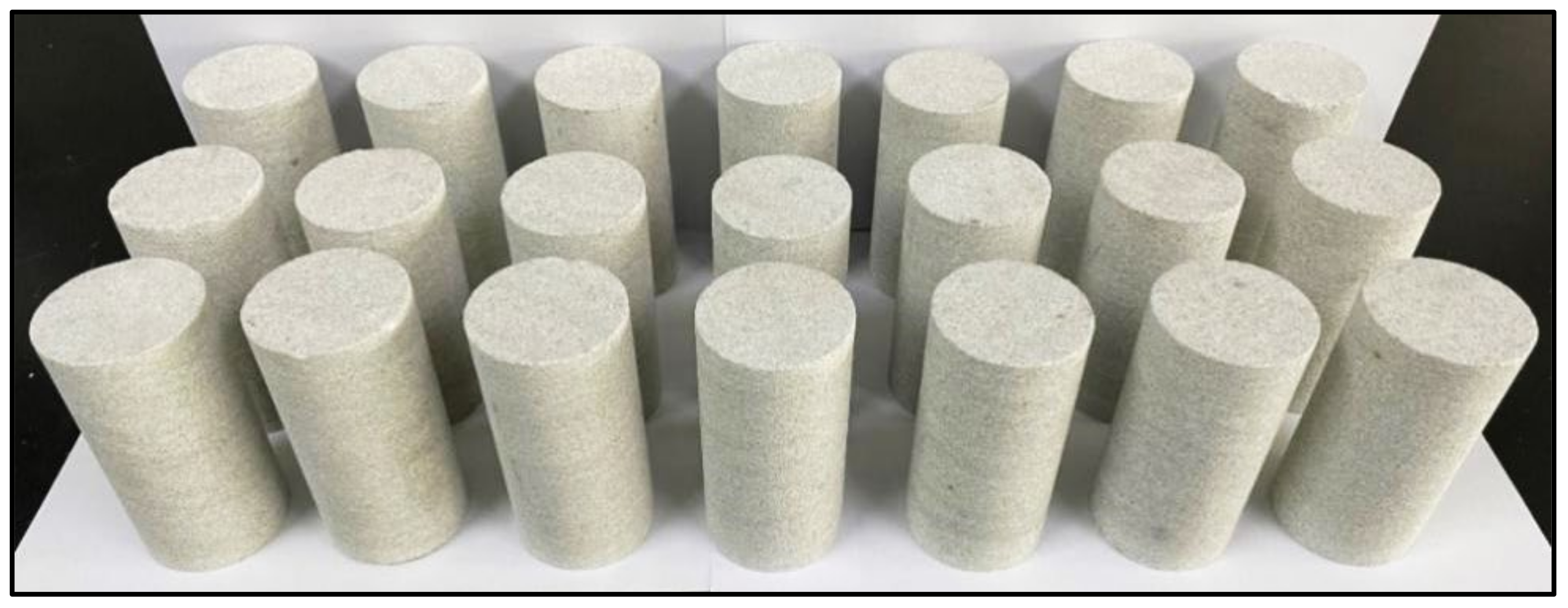

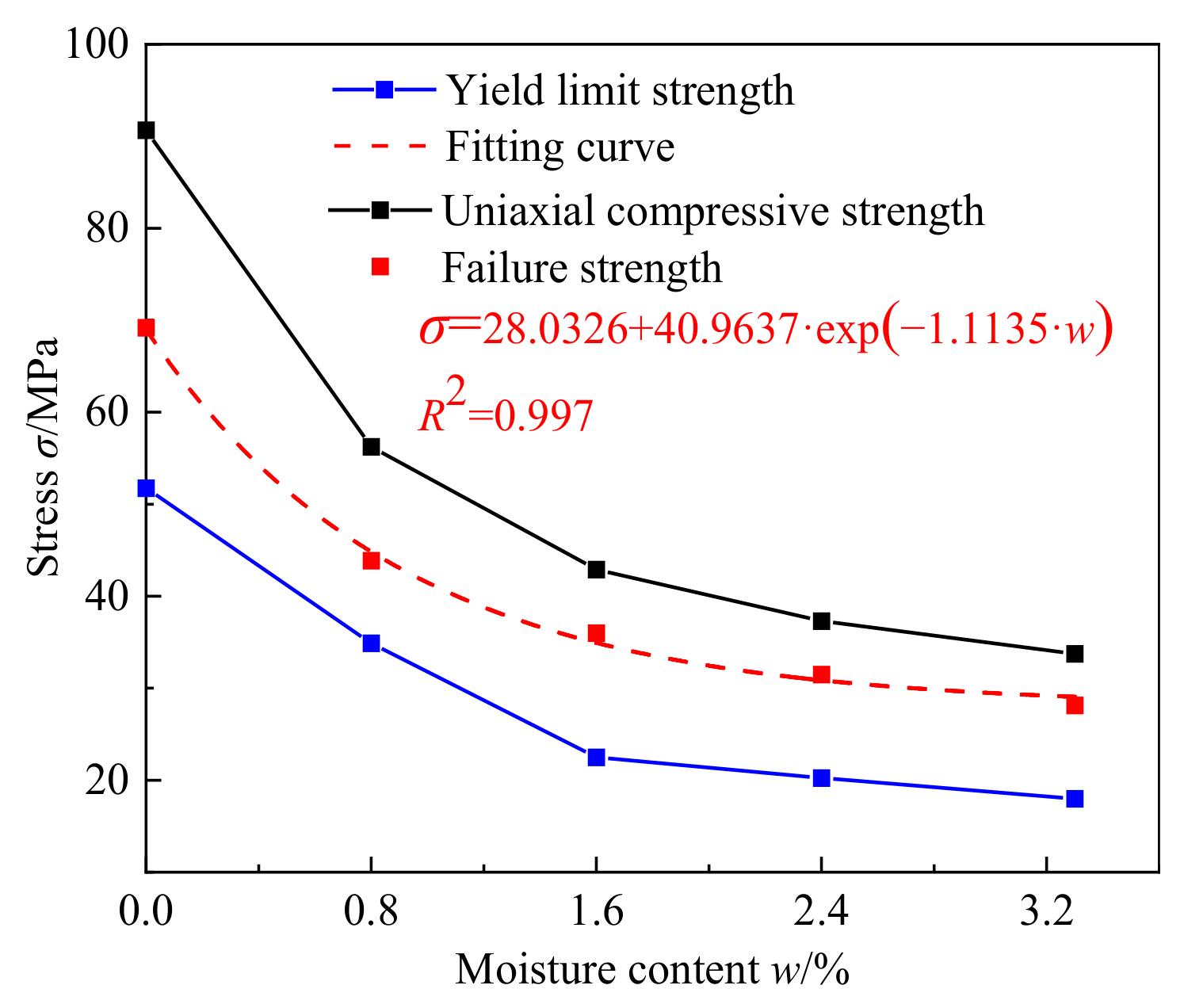
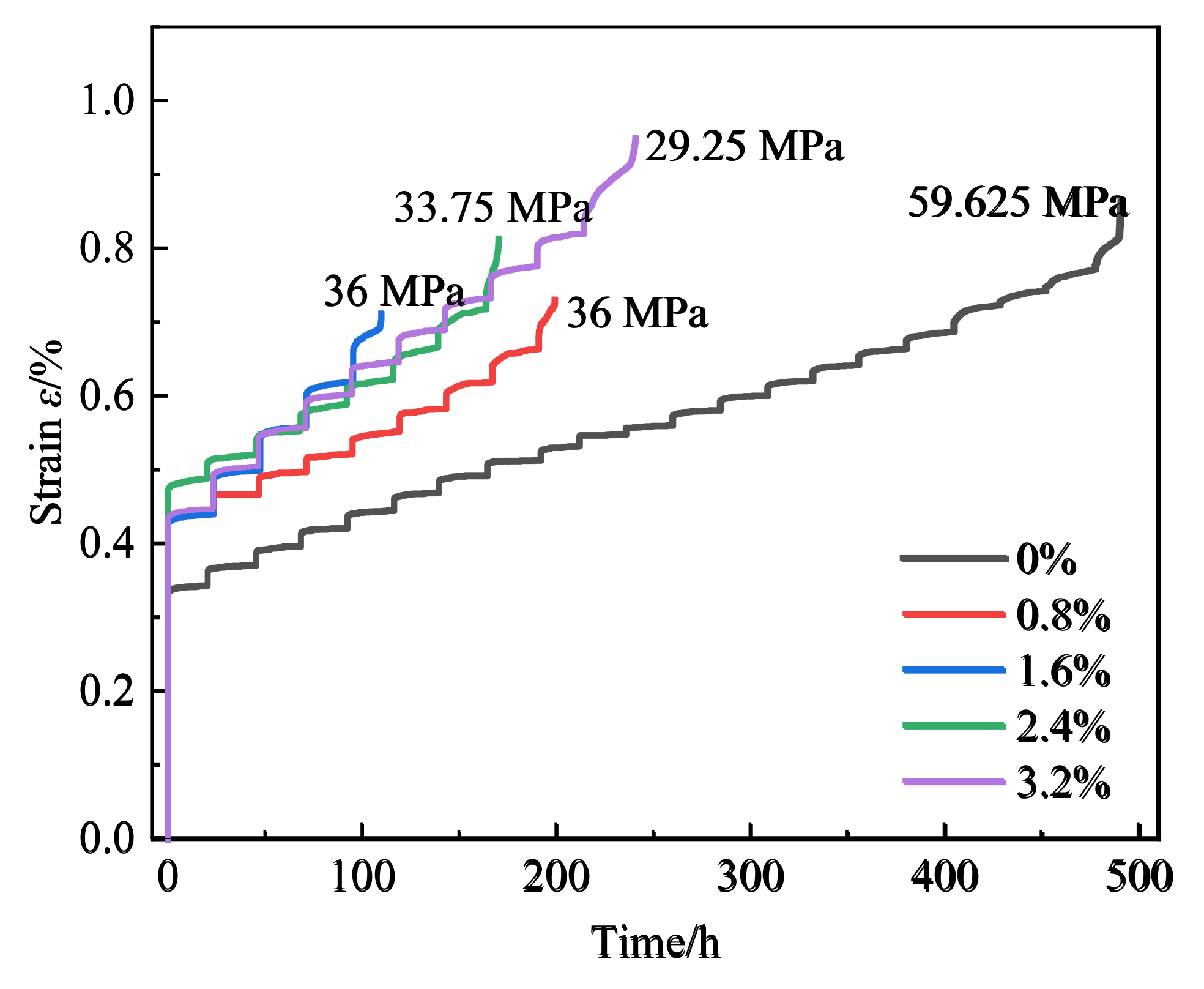
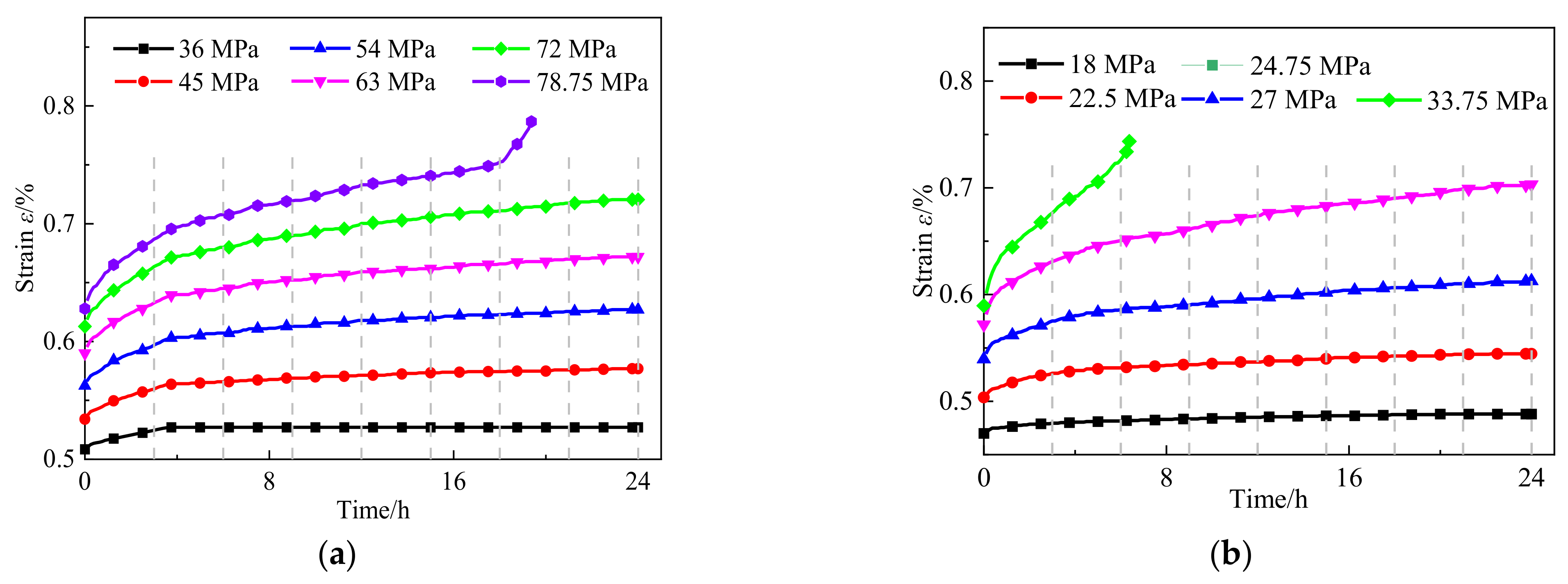
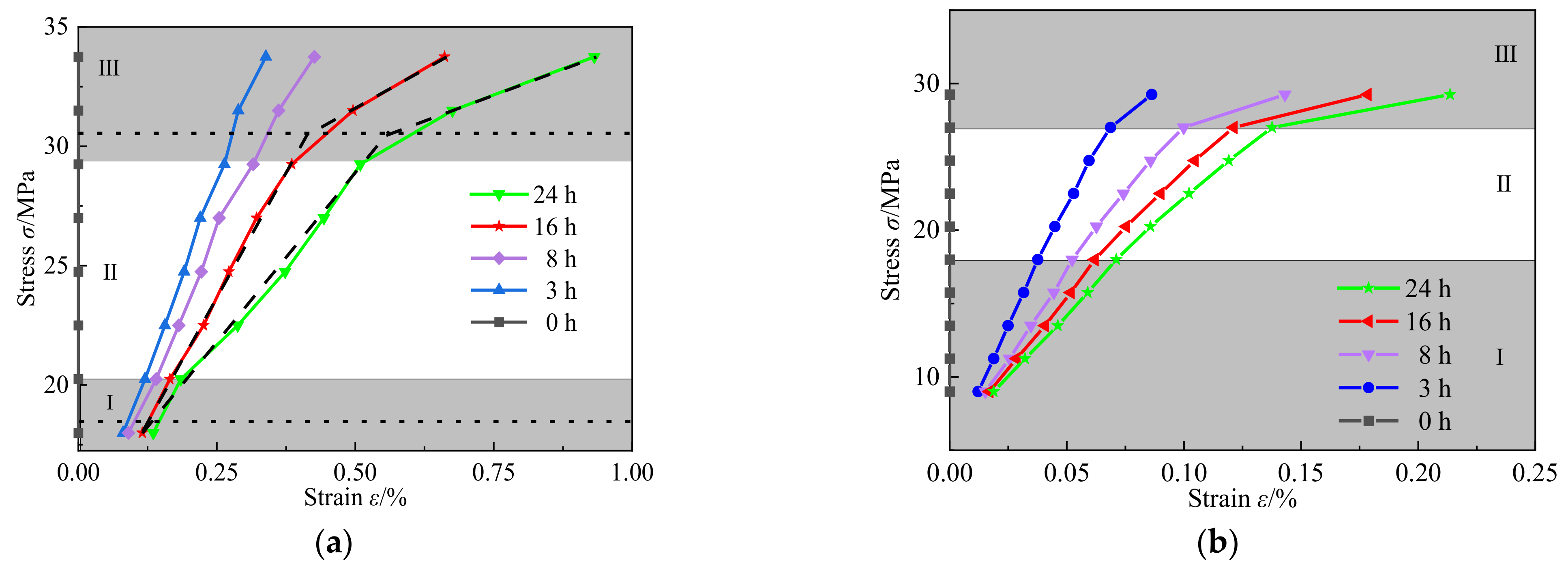


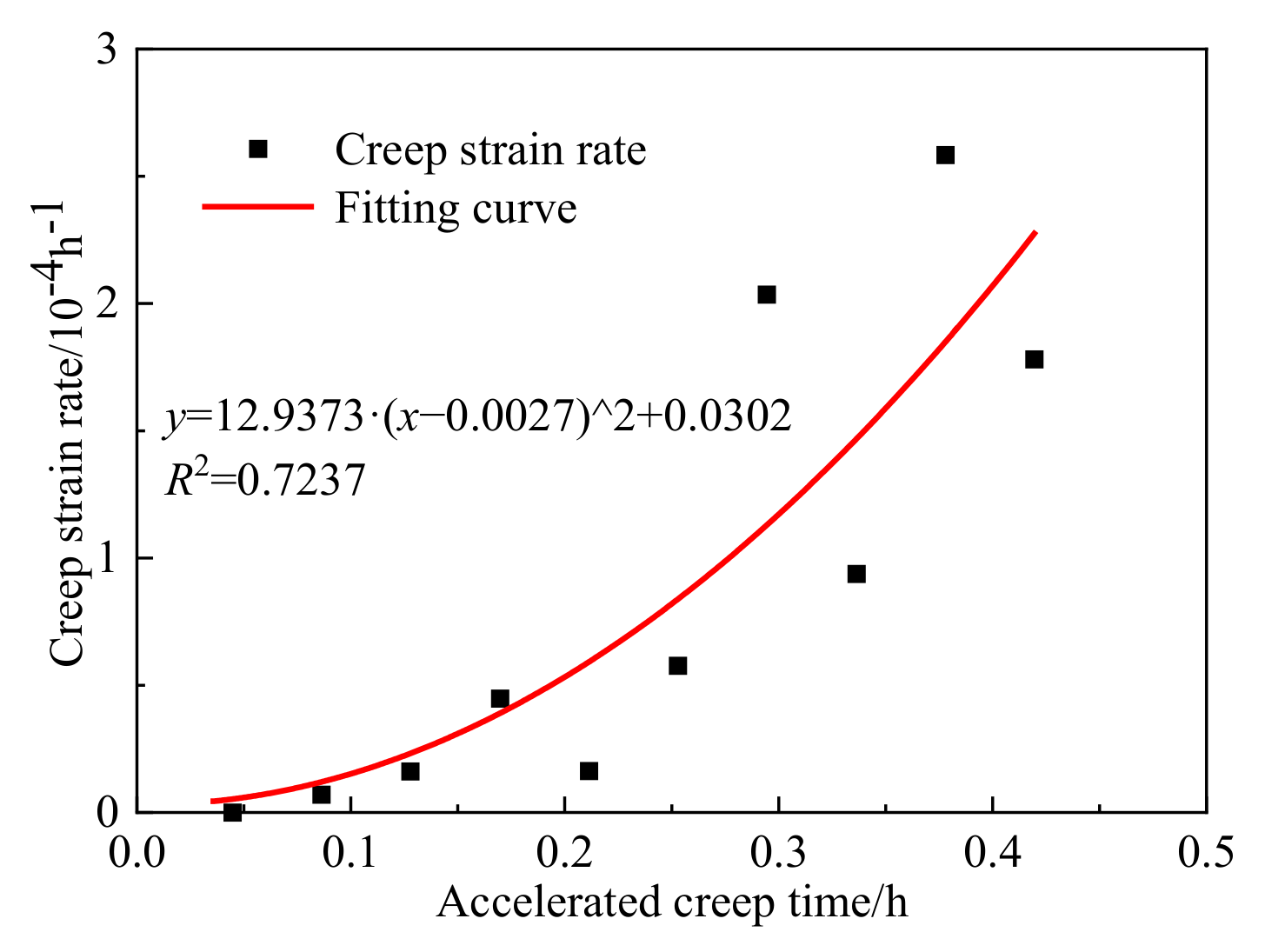

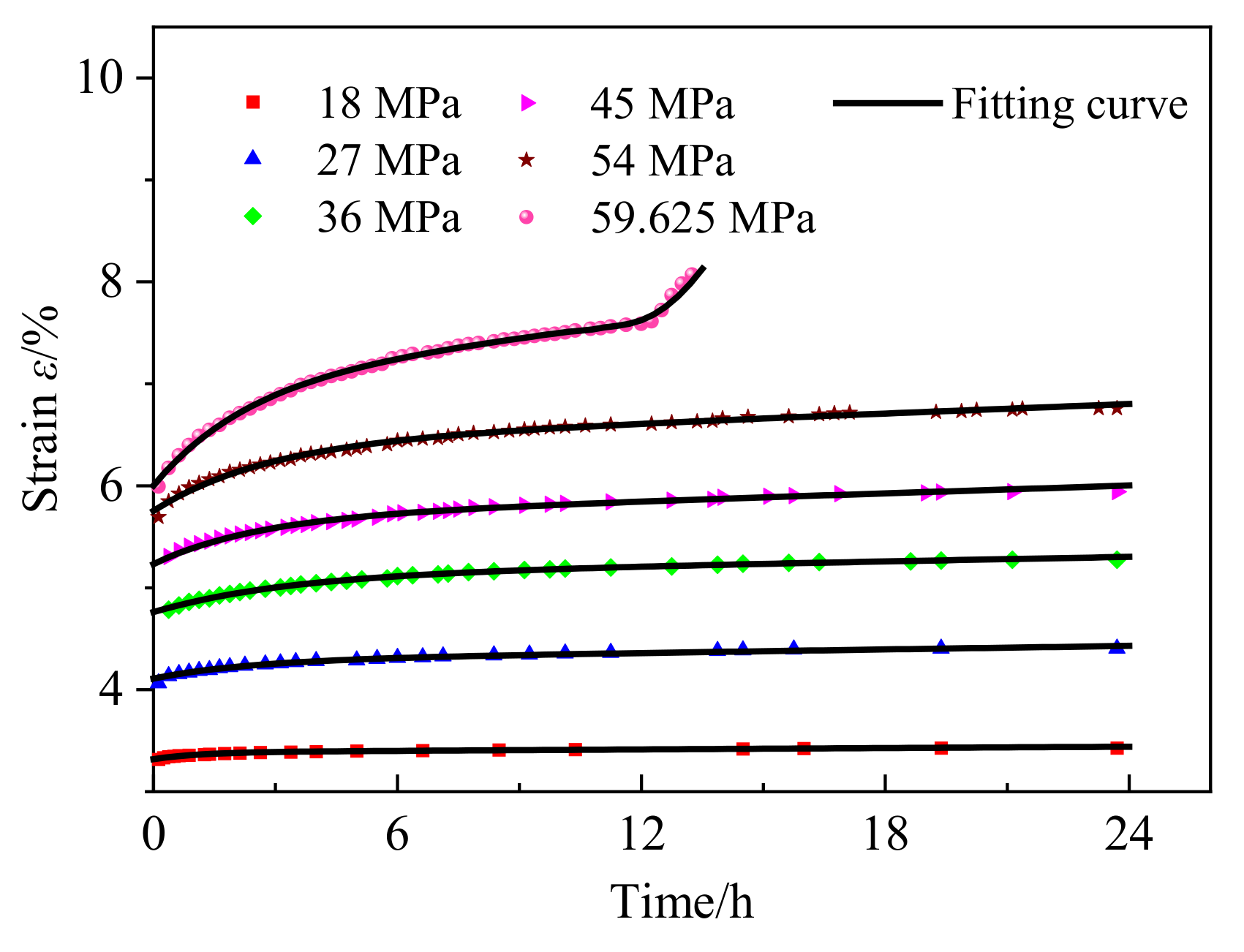
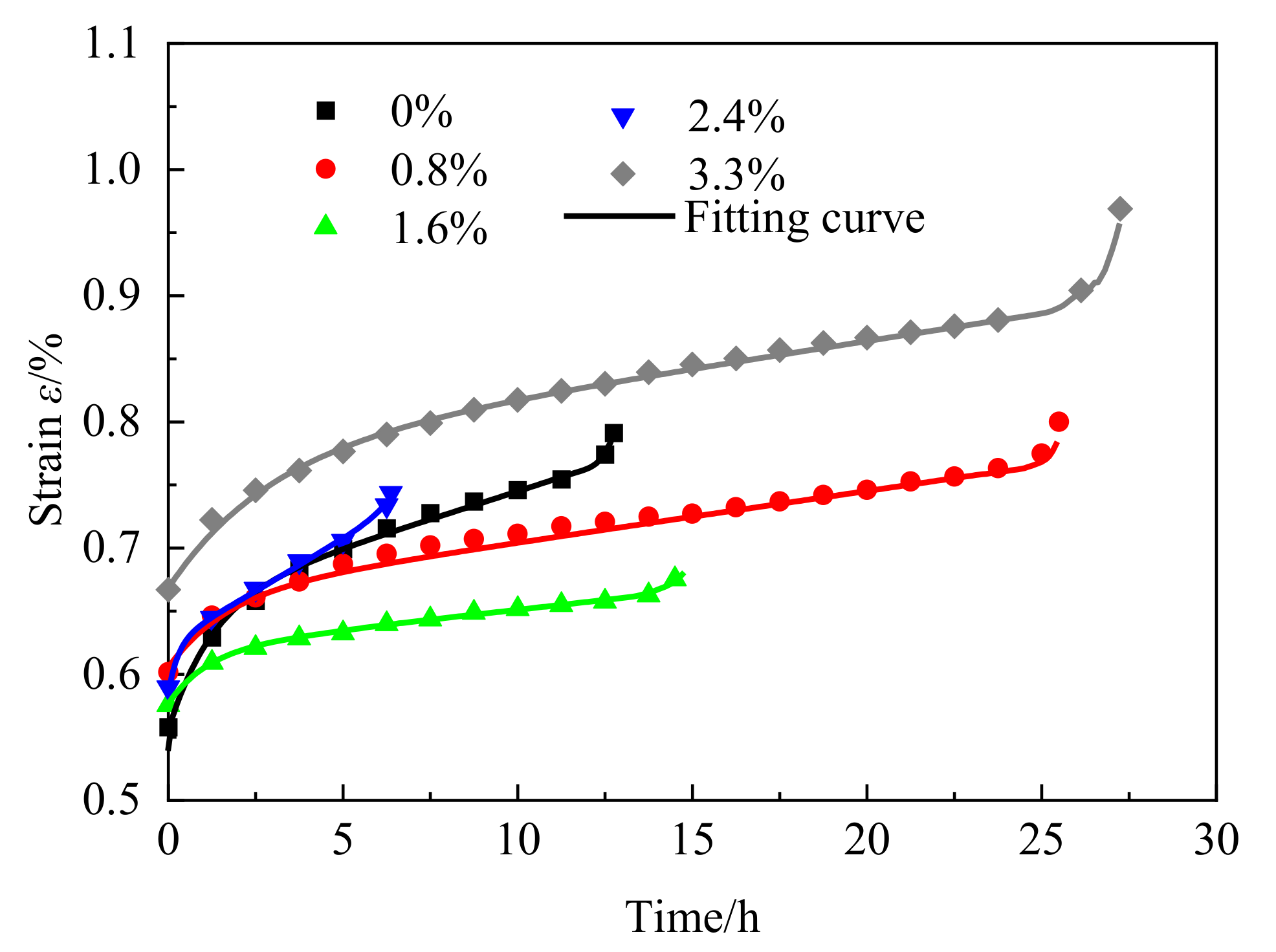
| Sample Number | Natural Quality (wn, g) | Dried Quality (wd, g) | Quality in the Aqueous State (wq, g) | Moisture Content (w, %) | Length (l, mm) | Diameter (mm) | Density (ρ, g/cm3) |
|---|---|---|---|---|---|---|---|
| R-20 | 463.03 | 462.33 | - | 0 | 100.99 | 49.48 | 2.38 |
| R-21 | 463.20 | 462.47 | 465.71 | 0.8 | 100.46 | 49.38 | 2.41 |
| R-22 | 472.96 | 472.10 | 479.63 | 1.6 | 101.35 | 49.58 | 2.42 |
| R-23 | 474.13 | 473.35 | 485.07 | 2.48 | 101.56 | 49.56 | 2.42 |
| R-24 | 460.33 | 459.55 | 474.66 | 3.32 | 99.59 | 49.43 | 2.41 |
| Moisture Content (w, %) | 0% | 0.8% | 1.6% | 2.4% | 3.2% | |||||
|---|---|---|---|---|---|---|---|---|---|---|
| UCS (MPa) | 90.67 | 56.25 | 42.91 | 37.30 | 33.74 | |||||
| Yield limit strength (σs, MPa) | 54 | 49.50 | 29.25 | 40.5 | 22.5 | 22.5 | 18 | 22.5 | 18 | 18 |
| Mean value (MPa) | 51.75 | 34.88 | 22.5 | 20.25 | 18 | |||||
| σs/UCS | 0.57 | 0.62 | 0.52 | 0.54 | 0.53 | |||||
| Accelerated yield strength (σas, MPa) | 54 | 76.5 | 27 | 47.25 | 27 | 31.5 | 24.75 | 27 | 22.5 | 27 |
| Mean value (MPa) | 65.25 | 37.13 | 29.25 | 25.88 | 24.75 | |||||
| σas/UCS | 0.72 | 0.66 | 0.68 | 0.69 | 0.73 | |||||
| Failure stress (σd, MPa) | 59.63 | 78.75 | 36.00 | 51.75 | 36.00 | 36.00 | 29.25 | 33.75 | 27.00 | 29.25 |
| Mean value (MPa) | 69.19 | 43.88 | 36.00 | 31.50 | 28.13 | |||||
| σd/UCS | 0.76 | 0.78 | 0.84 | 0.84 | 0.83 | |||||
| Moisture Content (%) | Creep Stress | Model Parameters | ||||
|---|---|---|---|---|---|---|
| E′0 (GPa) | E′1 (GPa) | η′1 (GPa·h) | η′2 (GPa·P) | ηn (GPa·h3) | ||
| 0 | 18 | 6.03 | 192.34 | 825.89 | ||
| 22.5 | 6.93 | 133.18 | 690.22 | |||
| 27 | 7.64 | 108.20 | 417.22 | |||
| 31.5 | 8.31 | 60.12 | 343.23 | |||
| 36 | 8.94 | 56.00 | 262.78 | |||
| 45 | 10.23 | 53.00 | 247.11 | 1964.02 | ||
| 54 | 11.26 | 52.11 | 196.44 | 1330.20 | ||
| 59.625 | 11.88 | 40.33 | 136.00 | 634.30 | 7.25 | |
| Number | Cohesive Force (c, MPa) | Internal Friction Angle (φ, °) | Poisson’s Ratio (μ) | E0 (GPa) | E1 (GPa) | η1 (GPa·h−1) | η2 (GPa·h−1) | ηnl (GPa·h−2) | ε (10−3) |
|---|---|---|---|---|---|---|---|---|---|
| DR-10 | 18.93 | 45.96 | 0.13 | 17.0 | 19.5 | 240 | 900 | 15.0 | −8.63 |
| DR-20 | 15.5 | 19.5 | 260 | 2200 | 100.0 | −8.35 | |||
| DR-11 | 13.03 | 42.97 | 0.23 | 13.5 | 42.5 | 240 | 1000 | 5.0 | −7.15 |
| DR-21 | 11.8 | 36.5 | 600 | 2600 | 50.0 | −9.40 | |||
| DR-12 | 9.60 | 41.35 | 0.25 | 9.8 | 15.0 | 300 | 800 | 25.0 | −7.03 |
| DR-22 | 10.3 | 14.0 | 1600 | 4200 | 50.0 | −7.09 | |||
| DR-13 | 8.96 | 40.16 | 0.28 | 9.7 | 19.0 | 380 | 650 | 40.0 | −7.43 |
| DR-23 | 10.1 | 15.5 | 440 | 840 | 20.0 | −7.70 | |||
| DR-14 | 8.14 | 39.75 | 0.30 | 9.1 | 35.0 | 580 | 520 | 0.7 | −7.70 |
| DR-24 | 8.9 | 5.5 | 1580 | 3200 | 7.0 | −11.13 |
Disclaimer/Publisher’s Note: The statements, opinions and data contained in all publications are solely those of the individual author(s) and contributor(s) and not of MDPI and/or the editor(s). MDPI and/or the editor(s) disclaim responsibility for any injury to people or property resulting from any ideas, methods, instructions or products referred to in the content. |
© 2023 by the authors. Licensee MDPI, Basel, Switzerland. This article is an open access article distributed under the terms and conditions of the Creative Commons Attribution (CC BY) license (https://creativecommons.org/licenses/by/4.0/).
Share and Cite
Chen, F.; Miao, C.; Jiang, M.; Sun, X. Experimental and Numerical Study of Water–Rock Coupling Creep under Uniaxial Compression. Sustainability 2023, 15, 14718. https://doi.org/10.3390/su152014718
Chen F, Miao C, Jiang M, Sun X. Experimental and Numerical Study of Water–Rock Coupling Creep under Uniaxial Compression. Sustainability. 2023; 15(20):14718. https://doi.org/10.3390/su152014718
Chicago/Turabian StyleChen, Feng, Chengyu Miao, Ming Jiang, and Xiaoming Sun. 2023. "Experimental and Numerical Study of Water–Rock Coupling Creep under Uniaxial Compression" Sustainability 15, no. 20: 14718. https://doi.org/10.3390/su152014718





